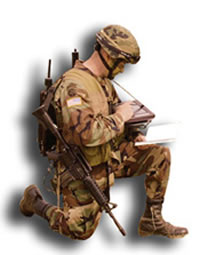Remote Optical Video Enhanced Receiver (ROVER) III was originally developed for the U.S. Air Force. The Rover III provides front line forces the capability to receive imagery directly from unmanned and manned aircraft. The Army, using the Rover III as the building block, planned to the existing inventory of legacy Remote Video Terminals (RVT) introducing a system compatible with the One System ground control system (GCS). The system produced by AAI corp. provides the same capability as the Rover III and the ability to overlay UAS telemetry directly on a moving map for improved situational awareness and targeting.
The new device enables users on the ground to receive information from remote sources using both analog L and C bands as well ad digital C band data-links. Further enhancements include the capability to interpret proprietary metadata, transmitted on many Unmanned Aerial Sensor (UAS) platforms.
 The CK-45 transciever, developed by L3 Communications supports three bands receive and C or Ku band for transmit, transferring up to 45 mb/sec data rate. The system enables ground elements, vehicular or dismounted, to share overhead imagery (sensor video) on the move, from various airborne sensors, such as helicopters, fighter aircraft and unmanned platforms. A rugged, manpack Rover III system supports reception over three bands – C, L and Ku, receiving sensor video and data from airborne sources. When employed with an omni-directional antenna, the system weighs only 12 lbs and can operate for 10 hours from a BA-5590 battery. Rover III receives sensor data from the Predator, Shadow 2000, Hunter, Fire Scout, Pointer, Dragon Eye and raven.
The CK-45 transciever, developed by L3 Communications supports three bands receive and C or Ku band for transmit, transferring up to 45 mb/sec data rate. The system enables ground elements, vehicular or dismounted, to share overhead imagery (sensor video) on the move, from various airborne sensors, such as helicopters, fighter aircraft and unmanned platforms. A rugged, manpack Rover III system supports reception over three bands – C, L and Ku, receiving sensor video and data from airborne sources. When employed with an omni-directional antenna, the system weighs only 12 lbs and can operate for 10 hours from a BA-5590 battery. Rover III receives sensor data from the Predator, Shadow 2000, Hunter, Fire Scout, Pointer, Dragon Eye and raven.
One System Remote Video Terminal (OSRVT) is currently produced in Block I configuration, offering receive only operating mode. It is a small, portable receiver and display system integrating live video and telemetry data from an array of manned and unmanned aircraft systems, including Shadow, Predator, I- GNAT, Raven, Pioneer, and Hunter. The system can receive and display video, data, and annotated maps improving the field commander’s situational understanding and decision making process. Video data is received with geo-location information. Video “footprint” and icons can be used to identify aggressor units, vehicles, facilities, and natural landscape features overlaid on a geo-location map, enabling swift target identification, decision making, and response. The basic system enables video reception within line of sight. The system’s extended-range antennas enable the OSRVT systems to meet mission range requirements with reception up to 80 kilometers.
On 25 October 2006 AAI Corporation announced it will deliver to the U.S. Army 51 remote video terminals (OSRVTs) and 38 extended- range antennas at a cost of US$3.9 million. On November 13, 2006 L-3 Communications announced it began shipping ROVER III data links. Follow-on systems, planned for FY08 and beyond, will consist of Block 2 OSRVT versions which will also enable active control of the payload. The Block 2 OSRVT will be fielded initially to the Shadow UAV Platoons and could potentially become the Ground Control equipment for the Small UAS.
















